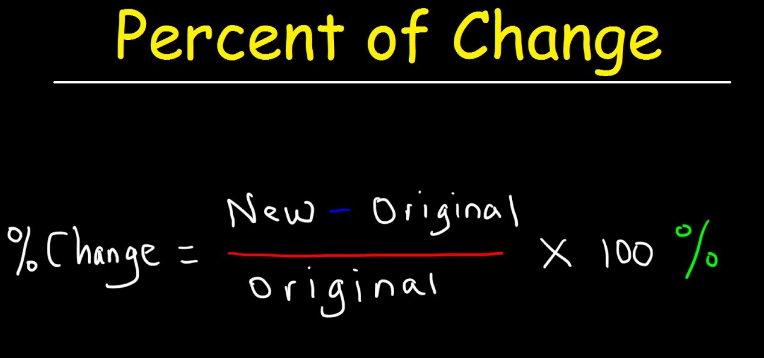A Comprehensive Guide to Calculating Percentage Increase and Understanding Percentage Differences

Understanding the concept of how to calculate percentage increase is an essential skill, whether you are a student, a professional, or simply someone looking to manage their finances more effectively. In this extensive guide, we’ll delve into the mechanisms behind this fundamental mathematical principle and address questions such as how do you calculate a 5% increase, and what is the difference in percentage between two numbers.
Also Read:- Diving Deep into the Square Root of 8: A Mathematical Exploration
Percentage Change | Increase and Decrease
To calculate the percentage increase:
First: work out the difference (increase) between the two numbers you are comparing.
Increase = New Number – Original Number
Then: divide the increase by the original number and multiply the answer by 100.
% increase = Increase ÷ Original Number × 100.
If your answer is a negative number, then this is a percentage decrease.
To calculate percentage decrease:
First: work out the difference (decrease) between the two numbers you are comparing.
Decrease = Original Number – New Number
Then: divide the decrease by the original number and multiply the answer by 100.
% Decrease = Decrease ÷ Original Number × 100
If your answer is a negative number, then this is a percentage increase.
Understanding the Basics:
At its core, a percentage is a number or ratio expressed as a fraction of 100. It is symbolized using the percent sign, “%.” The term “percentage increase” represents the degree to which a specific value has grown compared to its original amount. This mathematical operation is crucial in various fields, including finance, data analysis, and science, for analyzing trends, comparisons, and growth patterns.
The Formula of Percentage Increase:
The formula for calculating percentage increase is: Percentage Increase=(New Value−Original ValueOriginal Value)×100
Step-by-Step Guide to Calculating a 5% Increase:
To address the query, “how do you calculate a 5% increase?” let’s say, if you have an original value of $100:
- Convert the percentage increase (5%) to a decimal by dividing it by 100, yielding 0.05.
- Multiply the original value ($100) by the decimal equivalent of the percentage increase (0.05), giving an increase of $5.
- Finally, add the increase ($5) to the original value ($100) to obtain the new value, $105.
Understanding Percentage Difference:
Percentage difference is another critical concept related to percentage increase, and it measures the disparity, in percentage, between two numbers. The formula for calculating percentage difference is: Percentage Difference=|Value1 – Value2|(Value1 + Value22)×100
Calculating Percentage Difference between Two Numbers:
Let’s illustrate this with an example, considering two values, 10 and 15.
- Find the absolute difference between the two numbers: ∣10−15∣=5
- Find the average of the two numbers: 10+152=12.5
- Insert the values into the percentage difference formula: 512.5×100≈40 Thus, the percentage difference between 10 and 15 is 40%.
Finding the Percentage of a Number Relative to Another:
A common question is, “how do you calculate what percentage a number is of another number?” To find this, you use the following formula: Percentage=(PartWhole)×100 For instance, to find what percentage 20 is of 80: Percentage=(2080)×100=25
Practical Applications:
- In Finance:
- Calculating percentage increase helps in evaluating investment growth, inflation rates, and profit margins, thereby aiding in making informed financial decisions.
- Assessing percentage differences between two numbers aids investors in comparing the performance of different investments or portfolio values.
- In Retail:
- Retailers often use the concept of percentage to apply discounts, mark-ups, or to compare sales figures of different products or time periods.
- In Science and Data Analysis:
- Scientists and analysts use these calculations for comparing results, analyzing data, and detecting patterns or trends.
Enhancing Numerical Proficiency:
Being adept at calculating percentages, discerning percentage increases, and understanding percentage differences are vital skills in navigating the realms of academics, profession, and daily life. This competency not only facilitates logical reasoning and analytical thinking but also empowers individuals to make well-informed decisions and evaluations in various situations.
Conclusion:
Understanding and calculating percentage increase and percentage difference are foundational mathematical skills with widespread applications in diverse fields. The formulas and methods outlined above provide a structured approach to decoding these concepts, enabling a more profound comprehension of numerical relationships and disparities. Whether you’re examining investment growth or comparing sales data, the versatile utility of percentages is evident, making it an indispensable tool in our analytical arsenal.
In conclusion, this comprehensive guide has explored the intricate realms of percentage calculations, demystifying the concepts of percentage increase, percentage difference, and how one number is a percentage of another. As we navigate through a world increasingly reliant on data and numbers, cultivating a robust understanding of these fundamental principles is paramount in fostering informed decision-making and analytical prowess.
Final Thoughts:
Remember, percentages are all around us, influencing our decisions and shaping our understanding of the world. Cultivating proficiency in calculating percentage increases and understanding percentage differences is a step towards achieving numerical mastery, empowering us to approach a plethora of real-world scenarios with heightened insight and precision.
FAQs: How to Calculate Percentage increase
Q1: How do you calculate a percentage increase?
A1: To calculate a percentage increase:
- Subtract the original value from the new value.
- Divide the difference by the absolute value of the original value.
- Multiply the result by 100.
Percentage Increase=(New Value−Original ValueOriginal Value)×100
Q2: How do you calculate a 5% increase?
A2: To calculate a 5% increase:
- Convert 5% to a decimal by dividing by 100 to get 0.05.
- Multiply the original value by 0.05 to find the increase.
- Add the increase to the original value to find the new value.
Q3: What is the percentage difference between 2 numbers?
A3: Percentage difference between two numbers is calculated by:
- Finding the absolute difference between the two values.
- Averaging the two values.
- Dividing the absolute difference by the average value and multiplying by 100.
Percentage Difference=|Value1 – Value2|(Value1 + Value22)×100
Q4: What is the formula for percentage increase and increase?
A4: The formula for percentage increase is:
Percentage Increase=(New Value−Original ValueOriginal Value)×100
Increase is simply the difference between the new value and the original value.
Q5: How do you calculate what percentage a number is of another number?
A5: To calculate what percentage one number is of another:
- Divide the part (the number you have) by the whole (the total amount).
- Multiply the result by 100 to convert to a percentage.
Percentage=(PartWhole)×100








